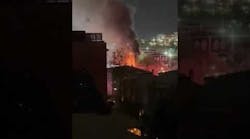The student will demonstrate a basic understanding of forcible entry tools and techniques by applying the material in a practical setting.
Session Reference: 7
Topic: Firefighter Pre-Basic VII
Level of Instruction:
Time Required: 3 Hours
Materials:
• Acquired Structure
• Forcible entry props
• Various hand tools
References:
• Essentials of Fire Fighting, Fourth Edition, IFSTA, Chapters 6 & 8
Preparation
Motivation:
Objective (SPO): The student will demonstrate a basic understanding of forcible entry tools and techniques by applying the material in a practical setting.
Overview: Firefighter Pre-Basic VII
• Introduction to Entry
• Entry Through Doors and Windows
• Introduction to Ventilation
• Ventilation Techniques
Instructors Notes: This lesson should be delivered as a combination of demonstration and student practice with the minimum amount of time spent on lecture. This material is designed to give the student some basic information on entry and ventilation. It is not intended to replace a Firefighter I program nor make the individuals fully-functional firefighters. It includes some basic information that any new firefighter should know to assist in an exterior mode on the fireground. Instructor should have tools, ventilation equipment, and props or a structure available for display, demonstration, and handling.
Firefighter Pre-Basic VII
SPO 7-1 The student will demonstrate a basic understanding of forcible entry tools and techniques by applying the material in a practical setting.
EO 7-1 Explain the basic principle associated with forcible entry including the need for such entry.
EO 7-2 Explain the entry techniques for selected doors and windows.
EO 7-3 Explain the principles and benefits of ventilation.
EO 7-4 Explain the natural, mechanical, and hydraulic ventilation procedures.
Instructional Guide
I. INTRODUCTION TO ENTRY (7-1)
When and Where to Enter
• Rescue requires immediate ventilation to remove smoke and heat and decrease danger to victims
• Firefighting ventilation can be delayed until hoselines are ready
Basic Door Construction
• Doors are made of metal or wood
• Doors may be single doors or double doors
• Doors may be solid or lighted (with glass)
• Doors may be exterior (heavier and solid) or interior (lighter and hollow core)
• Doors operate on hinges set in a frame of metal or wood
• The stop on the door frame that is part of the frame is the jamb (usually metal frames)
• The stop on the door frame that is attached to the frame is the stop (usually wood frames)
• Doors either open in (hinges on inside) or open out (hinges on outside)
Locking Devices in General Usage
• Mortise lock - positioned in edge of door with keyway and opening device separate
• Bore-in - keyway in door knob
• Rim - lock mounted on back of door with cylinder through door
• Adams-Rite - used on commercial doors with metal frames and glass
II. ENTRY THROUGH DOORS AND WINDOWS (7-2)
Entry Through Doors
• Commercial occupancies: front
• Almost easier to force entry through front door than rear
• In older buildings, front door might be constructed of wood or wood frame with ordinary glass
• In modern structures, front door made of tempered glass or heavy plate glass in strong frame
• Rear doors usually made of steel or reinforced with steel
• Front door protected by metal shutters, accordion-type barred grating, or similar devices
---------------------------------
• Wooden doors
• May or may not have cylinder locks
• Usually has bolts that engage keepers at top or bottom of door or both
• Double doors can be bolted to each other; pulling or forcing lock does not guarantee entry
• May have center panels which can be broken out for entry or opening door
---------------------------------
• Commercial occupancies: rear
• Steel doors
• Before attempting to force, checked for exposed locks or hinges
• If lock can be seen, drive pry tool between door and frame and force open
• If hinges exposed, pull hinge pins or drive tool between hinge and door facing
• Doors with neither lock nor hinges exposed cannot be forced with standard tools
• Doors may be secured with a steel bar or fox lock
• Door that cannot be forced can be cut open with power saw
• Heavy steel door can be opened with battering ram
---------------------------------
• Lighted doors
• In many older buildings, rear doors made of wood or light metal, reinforced with bars or fitted with several locks
• Main lock should be forced first
• Additional bolts or clocks can usually be forced with hand tools
• If door has glass pane without bars, best to remove glass and attempt to open lock from inside
---------------------------------
• Dwellings and apartments
• Locked residential structures more easily entered than commercial structures
• Front and rear doors usually same type and of light construction
• Often have one or more glass panes
• Multiple-unit street doors at front often unlocked
• Lobby door may be secured by electric lock
---------------------------------
• Apartment doors
• Might have to open individual doors
• In older buildings, doors made of wood - cylinder locks may have been added
• Frames of doors usually strong enough to support pry tool
• In modern buildings, doors made of steel or wood covered with steel - secured with cylinder locks and possibly one or more bolt-type locks
• If door frame constructed of light metal, might not support pry tool
---------------------------------
• Balcony doors
• Sliding glass with cylinder locks or some bolting arrangement holding at top and bottom
• Bolts should be forced with available tools
• If door particularly tough to force, drive pry tool between door and framing
• Two doors locked to each other can also be opened by driving pry tool between doors
• Avoid straining glass enough to break it
• Break glass for entry only for immediate rescue or when glass already stained or damaged by heat or smoke
• When bar or rod holds sliding section, glass will have to be broken
---------------------------------
• Office buildings
• Presents same problems as apartment house units
• Age of building determines type of inside office door, unless remodeled extensively
• Most buildings open to street during day
• Outside entrances usually similar to those found in stores of same general age
---------------------------------
• Other occupancies
• Warehouses and factories
• Usually have roll-up doors at loading platforms and heavy wooden or steel pedestrian doors
• Windows on lower floors may be barred
• Usually surrounded by chain-link fences - may require forcing padlock
• Some occupancies protected at night by guard dogs
---------------------------------
• Combination occupancies - may present double entry problem with forcing first into building and then into individual units
---------------------------------
Entry Through Windows
• Double-hung windows
• Window that allows simplest and quickest access to building
• Forced by prying up bottom section at center of window
• If top section made of small panes, pane nearest lock can be removed and window unlocked
---------------------------------
• If it must be used for entry and cannot be forced quickly, it should be completed knocked out
• If at ground level, use axe or other appropriate tool
• Above ground situations may be not be discovered until window is reached
• Remove all splinters of glass before going through
---------------------------------
• Position ladders upwind from windows
• When time and/or fire does not permit use of tool, knock out window with ladder
• Glass panes may be replaced with unbreakable plastic panes
• May be cut with power saw
• With other than steel frame, knock out entire window frame
• May have knock out panel which can be removed by striking corner with pick of axe
---------------------------------
• Casement windows
• Window hinged vertically with moving part of window attached to crank
• Window crank usually light
• Window lock located in middle or bottom of window
---------------------------------
• Best way to open window is break out pane of glass, reach in and unlock window, and force it open with pry tool
• If heat not intense, remove second pane to operate crank
• Many casement windows too narrow to allow entry
• Narrow windows often located at sides of large glass picture window
III. INTRODUCTION TO VENTILATION (7-3)
Ventilation Techniques and Theory
• Hot air rises using the path of least resistance and spreads or mushrooms out and downward
• Natural ventilation utilizes existing opening such as windows and roof openings
• Mechanical ventilation utilizes smoke ejectors or blowers
• Hydraulic ventilation utilizes nozzles and water flow air currents
---------------------------------
Importance and Timing of Ventilation
• Coordinate with fire attack since the increase in air flow will accelerate burning
• Ventilation removes smoke and heat and increases visibility
---------------------------------
Ventilation Equipment
• Smoke ejector - electric or gas-powered fan designed to exhaust smoke or blow in fresh air; air blows over motor; generally placed high in opening to exhaust smoke or low in opening to introduce fresh air
• Blower - electric or gas-powered fan designed to force air into an area at high velocity; placed six to ten feet from opening with air cone covering as much of the opening as possible
• Nozzle - nozzle is positioned two to three feet from opening with stream covering as much of opening as possible (at least 90%)
---------------------------------
Backdraft
• A condition where there is insufficient air to support combustion
• A sudden introduction of fresh into an oxygen-starved fire causes a backdraft explosion
• Signs of backdraft include puffing smoke going in and out of the building, dark smoke in the structure with little flame, smoke emitting from openings in building
• Backdraft is relieved by venting at the highest point in the structure
---------------------------------
Roof Construction
• Shingle - consists of plywood sheathing on roof trusses, tar paper, and asphalt shingles
• Composition - consists of wood or metal sheathing covered with felt material; tar and gravel provides water resistance
IV. VENTILATION TECHNIQUES (7-4)
Windows
• When time permits, windows should be opened
• Double hung windows should be opened two-thirds down from the top and one-third up from the bottom
• Open other types of windows as much as possible
• Storm windows must also be opened or removed
• Shades, blinds, drapes, curtains, and other window coverings must be moved away or removed
• When wind is a factor, windows on leeward side should be opened first
---------------------------------
• Window and roof ventilation
• When roof or roof features must be opened for venting, windows on top floor should be opened
• If windows on several floors must be opened, begin on top and work down
• Opening windows from below first may cause fire and smoke spread
---------------------------------
Natural Roof Openings
• In multi-story buildings, vertical shafts carry stairways, elevators, dumbwaiters, electric wiring, heating ducts, and plumbing and sewer pipes
• Shafts extend full height of building
• Convected heat, smoke, and gases will rise within and around shafts
• If shafts are not vented at top, fire will travel horizontally
• Pressure will force heat, smoke, and gases throughout upper part of building
• Shafts are capped at roof with various closures (make sure of area being vented when cap is removed)
---------------------------------
Cutting Through Roofs
• At times, only way to properly ventilate is cut hole in roof
• Roof made of boards can be cut with axe
• Roof made of plywood should be cut with power saw
• Care should be taken not to cut joists or other structural members
---------------------------------
• Single large hole is more effective than several small holes
• One 4' X 8' hole has twice area of four 2' X 2' holes
• All roof boards should be cut through before any pulled up
• Keep back to wind when pulling boards
• When all boards ripped up, make opening in ceiling below
---------------------------------
• Special care should be taken when fire is immediately below roof
• Open roof as close as possible to seat of fire
• If not, fire will be drawn across top of building to opening
• Hot spots may develop on roof
• If roof is flat, opening should be made at hot spot
• On gabled roof, opening should extend from hot spot to peak
• Draft can be increased by making an additional opening just above the eave line on side opposite original opening
• Care should be taken so that opening does not increase fire spread
---------------------------------
Forced Ventilation
• Smoke ejectors
• Cannot be used as a substitute for natural venting techniques
• Fans should not be used in partially or completely confined spaces in which there is fire
• May be used in confined areas after fire has been knocked down
---------------------------------
• Fan placement
• Most effective when placed where they tend to increase natural air flow
• When fans are positioned in windows or doorways, all shades, drapes, blinds, curtains, and screens should be removed
• If possible, open area around fan should be closed to increase fan efficiency by directing air through opening and preventing smoke from re-entering
• Be careful not to exhaust smoke into congested areas or into heating and cooling intakes
---------------------------------
• Fans in tandem
• Can be especially effective when used in pairs
• Place one fan near an outside opening blowing smoke out and other inside room to blow smoke to first fan
• Fans can be used to exhaust smoke and draw in fresh air at same time
• Exhaust fan should be mounted high in vent opening
• Intake fan should be lower
---------------------------------
• Positive pressure fans
• Introduction
• Fresh air introduced to increase pressure
• Selective process of opening and closing doors and windows - effective on all structures when doors and windows maintained
• Initiated outside structure
• Has potential of moving fire and fire gases
• Generally speaking, initiated between fire fighters and fire or between fire and trapped victims
• Can maintain primary and secondary egress routes
• Quicker than negative ventilation
• Works well in large areas
---------------------------------
• Fan placement
• Place fan far enough away from door to fill opening with cone of air
• Stacking fans increases volume greatly
• For oversized doors, place fans side by side or in tandem
• For single fan, place 6 to 10' from doorway
• For multiple fans, place 3 to 5' from doorway
---------------------------------
• Fog streams
• Can be used to start venting immediately after fire has been knocked down
• To be most effective, stream should be positioned so fog pattern covers most of window opening
• Hold nozzle few feet inside window
• Observe smoke movement to determine proper position of nozzle
• Fog streams should not be used for venting if they damage
• Items removed for protection
• Outside of fire building or enter adjourning buildings
• Inside of room from which directed
---------------------------------
• They should not cause ice to form outside
• Should be short term operation
Summary
Review:
Firefighter Pre-Basic VII
• Introduction to Entry
• Entry Through Doors and Windows
• Introduction to Ventilation
• Ventilation Techniques






